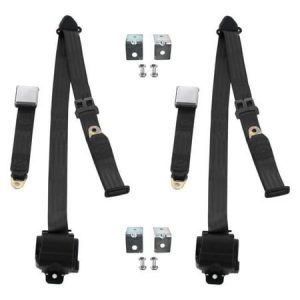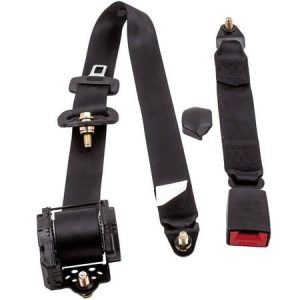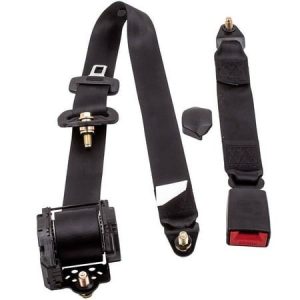The seat belt, a simple yet life-saving invention, has revolutionized road safety. But have you ever wondered who invented the seat belt, and how it came to be the essential piece of safety equipment it is today? This article delves into the fascinating history of the seat belt, exploring its evolution from rudimentary beginnings to the modern three-point design we know today.
Early Concepts: From Gliders to Automobiles (1800s-1930s)
The concept of restraining passengers in a moving vehicle dates back to the early days of transportation. In the mid-1800s, English engineer George Cayley, considered a pioneer in aeronautics, is credited with inventing the first-ever seat belt for use in his glider. This early design was likely a simple strap to prevent occupants from being thrown out during flight.

Fast forward to the invention of the automobile in the late 19th century. While cars offered a new mode of transportation, they also presented new safety concerns. Early automobiles lacked any form of restraint for passengers, making them vulnerable to serious injuries in crashes.
By the 1930s, as car speeds increased and accidents became more common, concerns about passenger safety grew. Doctors in the United States began advocating for the use of seat belts in automobiles. Early versions included two-point lap belts, which were offered as an optional feature in some car models.
The Lap Belt and the Push for Safety (1940s-1950s)
The 1940s saw a rise in car ownership and a continued focus on improving safety features. American car manufacturer Nash became the first to offer seat belts as a standard option in their 1949 models. However, these early lap belts were uncomfortable and inconvenient, leading to low usage rates.
Despite the limitations of early seat belts, data from accidents began to show their effectiveness in reducing injuries. Dr. Claude H. Sheldon, a leading researcher in automotive safety, actively campaigned for the mandatory use of seat belts. He proposed various safety features, including retractable seat belts and reinforced car structures, to improve overall occupant protection.
The Three-Point Seat Belt: A Breakthrough in Safety (1950s)
The invention of the modern three-point seat belt in the 1950s marked a significant turning point in automotive safety. While a patent for a three-point design existed as early as 1955, it was Swedish engineer Nils Bohlin who is credited with developing the version used in most cars today.

Working for Volvo, Bohlin designed a three-point belt that distributed the force of a crash more evenly across the body, reducing the risk of serious injuries. This design proved to be far more comfortable and effective than previous lap belts, leading to increased adoption by car manufacturers.
Volvo, recognizing the life-saving potential of the three-point belt, made a groundbreaking decision. Instead of patenting the design and profiting exclusively, they chose to make it freely available to all car manufacturers. This selfless act ensured the widespread adoption of the three-point belt and undoubtedly saved countless lives.
Legislation and Public Awareness: The Road to Mandatory Use (1960s-1990s)
Despite the clear safety benefits of seat belts, their use remained low in the early 1960s. Public awareness campaigns and educational efforts played a crucial role in changing attitudes. In the United States, the passage of the National Highway Traffic Safety Administration (NHTSA) Act in 1966 mandated the installation of seat belts in all new cars.
However, mandatory installation did not equate to mandatory use. Throughout the 1970s and 1980s, states began implementing laws requiring drivers and passengers to wear seat belts. These laws, coupled with continued public education efforts, led to a significant increase in seat belt usage rates.
Modern Advancements: Beyond the Three-Point Belt (2000s-Present)
While the three-point seat belt remains the primary restraint system in automobiles, advancements in automotive safety technology have led to the development of additional features. These include:

- Pretensioners: These devices automatically tighten the seat belt in the event of a crash, further reducing slack and minimizing occupant movement.
- Load limiters: These features are designed to release a small amount of slack in the belt during a crash to reduce the risk of chest injuries.
- Airbags: While not a replacement for seat belts, airbags provide additional protection in frontal crashes. They work in conjunction with seat belts to absorb impact and further reduce injuries.
These advancements, along with ongoing research and development in automotive safety, continue to improve occupant protection in modern vehicles.
The Seat Belt: A Legacy of Safety
The impact of seat belts on road safety is undeniable. Studies by the National Highway Traffic Safety Administration (NHTSA) show that seat belts reduce the risk of fatal injuries for front-seat occupants by 45% and the risk of moderate to serious injuries by 60%. Seat belts are estimated to save over 14,000 lives in the United States each year.
Beyond the immediate benefits for those involved in crashes, seat belts also have a significant economic impact. By reducing injuries and fatalities, seat belts help to lower healthcare costs and lost productivity due to traffic accidents.
The widespread use of seat belts has transformed road safety, making it a key factor in reducing the overall number of traffic fatalities over the past few decades.
Seat Belt Use Today: Challenges and Solutions
Despite the overwhelming evidence of their effectiveness, seat belt use remains less than perfect. According to the NHTSA, national seat belt usage rates hover around 90% for drivers and 85% for front-seat passengers. However, usage rates for rear-seat passengers are significantly lower, with estimates suggesting only around 50% of people buckle up in the back seat.
Several factors contribute to these lower usage rates. Some drivers and passengers may have a false sense of security due to modern safety features like airbags. Others may find seat belts uncomfortable or inconvenient. Additionally, a lack of enforcement in some areas can lead to complacency.
To address these challenges, various strategies are being employed to increase seat belt usage rates. These include:

- Public awareness campaigns: Educational campaigns continue to highlight the importance of seat belts for all occupants in a vehicle.
- Law enforcement: Continued enforcement of seat belt laws sends a clear message about the importance of buckling up.
- Technological advancements: Some car manufacturers are exploring features that automatically detect unbuckled passengers and emit chimes or warnings until they buckle up.
By implementing a combination of these approaches, we can strive towards achieving universal seat belt use and further reducing the number of road fatalities.
Choosing the Right Seat Belt for Your Needs
While the three-point seat belt is the standard design used in most vehicles, there are some variations to consider. Here are some factors to keep in mind when choosing a seat belt:
- Vehicle compatibility: Ensure the seat belt is compatible with the make and model of your car.
- Child safety: If you transport children in your vehicle, you will need age-appropriate child safety seats and booster seats. These provide additional protection and ensure proper seat belt fit for young passengers.
- Replacement parts: In rare cases, you may need to replace a damaged seat belt. Look for OEM (original equipment manufacturer) parts to ensure compatibility and proper functionality.
Remember, the best seat belt is the one you wear every time you get in the car.
Buckle Up for Life
The seat belt is a simple yet powerful tool that can save your life and the lives of those you share the road with. By buckling up every ride, you take a proactive step towards ensuring your safety.
Here are some key takeaways to remember:

- Seat belts are the most effective way to reduce the risk of serious injuries and fatalities in a crash.
- Seat belts are essential for all occupants in a vehicle, regardless of seating position.
- Public awareness campaigns, law enforcement, and technological advancements can all play a role in increasing seat belt usage rates.
- Choose the right seat belt for your vehicle and ensure proper fit for all passengers, especially children.
Make buckling up a habit. By taking a few seconds to fasten your seat belt, you can significantly increase your chances of arriving at your destination safely. So buckle up for life – it’s the smartest ride you’ll ever take.


